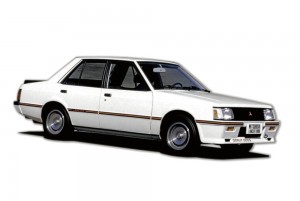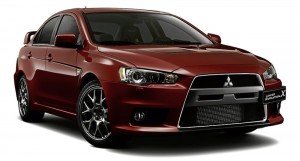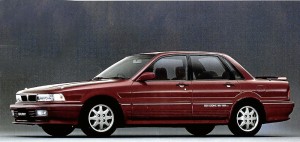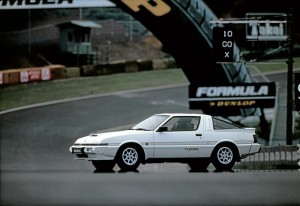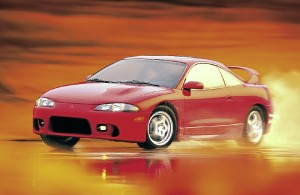Mitsubishi’s Diamonds
Mitsubishi Motors is celebrating its 50th anniversary in the Philippines. The company has seen every trend, crisis and growth cycle played out, and has taken advantage of nearly all of them. The resulting lineup was always worth considering and some emerged as exceptional. Here are some of the memorable vehicles that spelled success for Mitsubishi Motors Philippines:
Lancer ‘Box Type’
The 1979 Lancer is remembered for its styling, a three-box profile with a slightly wedge-like front end. Its simplicity belied some innovative engine technology, which included counter-rotating balance shafts to quell the vibrations of the inline-four engine. This model of Lancer flourished until the late 1980s, surviving the economic turmoil of the last years of the Marcos administration.
Lancer Evolution
The humble Lancer sedan became the basis of a performance line dubbed the Evolution. Using the formula of a powerful engine in a light chassis, with the grip of all-wheel drive, the Evo provided sports car levels of performance. The first Evo borrowed the 2.0-liter turbocharged engine and all-wheel drive system of the Galant VR-4. Horsepower and sophistication of its performance increased through the years, easy vaulting past the official 280-HP mark of early models. Mitsubishi Philippines started officially importing the Evo with the fourth generation circa 1996.
Colt / Mirage
Also known as the Mirage, the Colt was Mitsubishi’s offering in the subcompact range. A front-wheel drive hatchback, the Colt was an economical car. It was developed as a response to the oil crisis of 1973, and the car was launched in 1978. The Colt name was later given to a new generation of hatchbacks, not released locally.
New Mirage
Mitsubishi scored a strong hit with its new Mirage subcompact. Developed for Japanese and Asean markets as an economical car, the new Mirage packs a 1.2-liter engine with Mivec variable valve timing. Mitsubishi quotes up to 21 km/liter. The cheerful-looking hatchback starts at P498,000, giving even Chinese cars a run for their money.
Galant GTi
The Galant nameplate reached its apex with the 1992 GTi-16V. Mitsubishi’s claim that it was a supercar was stretching the definition, but the GTi-16V had performance above its rivals. Its 2.0-liter engine was imbued with dual overhead cams, 16 valves and multiport fuel injection, the first in its class to have all three features. With 145 HP on tap, its top speed was a quoted 205 kph. It borrowed the look of the fire-breathing VR-4, complete with bulldozer-like air dam and a wing-type rear spoiler.
Strada
Looking every bit like a concept truck, the Strada is one pickup geared as much for personal transport as for work. A comfortable, roomy cabin packs plenty of electronic gadgetry, and the handling is responsive enough for tight city streets. It hasn’t forgotten that it’s a workhorse, with up to 350-Nm engines available for heavy hauling.
Montero Sport
The ubiquity of the Toyota Fortuner made a rival inevitable, and the Montero Sport has been the only one to depose it from the top-selling SUV slot. In its favor are a narrower chassis and quicker steering response. It borrows the good looks of its Strada sibling, and comes with the requisite turbocharged diesel power as well.
Pajero
The SUV as luxury vehicle was locally pioneered by this vehicle. Driving one became a status symbol in the 1980s and 1990s, attracting envy from men and admiration from women. It was so successful at this that the brand developed some infamy, becoming associated with thieving ladies (“Pajero lady”) and dubious clergymen (“Pajero priests”). No matter, the reputation for being a comfortable and commanding SUV continues until the current generation.
Space Wagon
A swing-door station wagon that could accommodate seven in three rows of seats, the Space Wagon was a model of efficiency in packaging. The seven-seat wagon is still a rare model these days, befuddling given the success of the Space Wagon.
Eclipse
A sports car built on the all-wheel drive chassis of the Galant, the Eclipse was a decent performer with its turbocharged 4-cylinder engine. It was perhaps ahead of its time, as a Mitsubishi sports car would be just the ticket to compete in the currently crowded affordable sports-car market.
Adventure
Mitsubishi’s entry in the Asian Utility Vehicle, the Adventure became the vehicle of choice for tens of thousands of families. The Philippine-assembled Adventure has been the company’s best-selling vehicle.
L300
Mitsubishi’s Methuselah, the L300 has been produced in more or less the same form since the late 1970s. While its popularity as family transport has waned due to more modern rivals, if you need a small cargo truck, chances are the L300 will still be at the top of your shortlist.
Currently, the carmaker occupies second place in terms of unit sales, buoyed by the success of the Montero Sport and Strada. With those utility vehicles as the cornerstone of its strategy, and with a rejuvenated Lancer and attractively-priced Mirage bolstering its passenger car lineup, Mitsubishi is poised to be in the lead in many segments.

